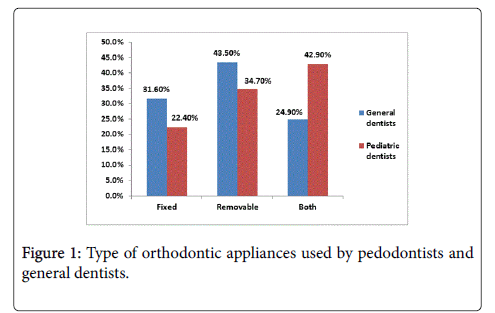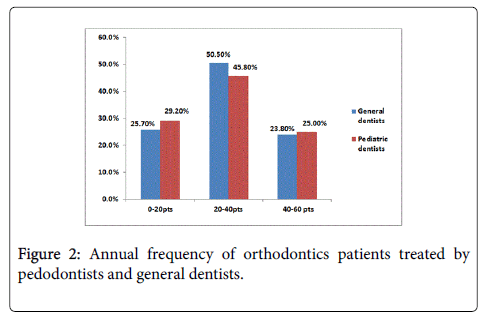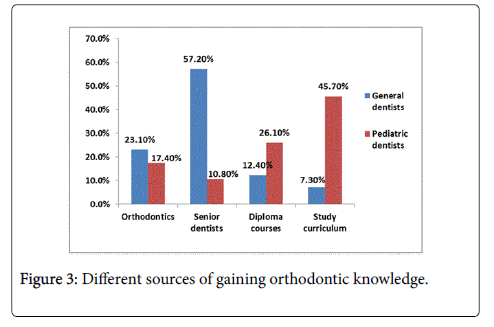Research Article Open Access
Practice and Attitude towards Orthodontic Services by Pedodontists and General Practitioners
Akshay G1, Anur G1, Singh K2* and Singh T31Department of Orthodontics and Dentofacial Orthopaedics, Indira Gandhi Government Dental College and Hospital, Jammu, India
2Department of Public Health Dentistry, Luxmi Bai Institute of Dental Sciences & Hospital, Patiala, India
3Oral and Maxillofacial Surgery, Luxmi Bai Institute of Dental Sciences & Hospital, Patiala, India
- *Corresponding Author:
- Dr. Karanprakash Singh
Reader, Department of Public Health Dentistry
Luxmi Bai Institute of Dental Sciences & Hospital
Patiala, India
Tel: +918437112344
E-mail: drkarankahlon@gmail.com
Received Date: April 26, 2017; Accepted Date: April 26, 2017; Published Date: April 30, 2017
Citation: Akshay G, Anur G, Singh K, Singh T (2017) Practice and Attitude towards Orthodontic Services by Pedodontists and General Practitioners. J Interdiscipl Med Dent Sci 5: 211. doi:10.4172/2376-032X.1000211
Copyright: © 2017 Akshay G, et al. This is an open-access article distributed under the terms of the Creative Commons Attribution License, which permits unrestricted use, distribution, and reproduction in any medium, provided the original author and source are credited.
Visit for more related articles at JBR Journal of Interdisciplinary Medicine and Dental Science
Abstract
Objective: The study aimed to evaluate the provision of orthodontic skills among general and pediatric dentists. Methods: The study included 344 subjects, who were given a questionnaire that included information like experience of practice, type of orthodontic appliances used, frequency of orthodontic patients treated yearly, etc. Mean scores of all the questions were calculated using student’s t test and one-way ANOVA test at p value <0.05. Results: In general, percentage of participants practicing orthodontics was 22.1%. It was observed that more number of pedodontists were involved in orthodontic treatment than general dentists. Removable appliances were frequently used for patients. The prevalence of practicing orthodontic treatment was mostly observed in more experienced practitioners. Conclusion: The frequency of providing orthodontic treatment was significantly higher amongst pediatric dentists. However, orthodontic courses should be made available for the dental practitioners for further excellence.
Keywords
General dentists; Orthodontics; Pediatric dentists
Introduction
Malocclusion is the second most commonly detected dental diseases among children and young adults, next to dental caries [1]. The prevalence of malocclusion differs from place to place and among different ages, gender and location. Its incidence has been reported to vary from 11% to 93% [2-4].
Malocclusion has shown its role in affecting periodontal health, dental caries and temperomandibular joint (TMJ) problems [5]. Hence, the orthodontic treatment is necessary for correction of malocclusion in the population. Also the demand for orthodontic therapy is increasing [6], yet the basic orthodontic services provided by the dentists are not fulfilling the requirements; mainly in the rural areas [7].
On the other hand, the number of general and pediatric dentists who afford orthodontic services is increasing. This is perhaps due to the increase in the need of orthodontics among the children [8]. Orthodontic procedure done by pedodontics and general dentists has been reported in many studies, but the results are contradictory [9,10].
Further, there are also cases of referrals to orthodontic clinics from pediatric and general dentists [11]. General dental practitioners are in fact considered to be gatekeepers for specialist orthodontic care [12]. Unfortunately, very few studies have mentioned about the orthodontic treatment provided by them. Hence, the present study was carried out to assess the practice and attitude of general and pediatric dentists for orthodontic services.
Methodology
A descriptive cross-sectional study was conducted in January 2015 among 344 dentists in Jammu, located in the Northern India. The study included 44 pedodontists and 300 general dental practitioners.
A well structured questionnaire was prepared that included information like demographics, experience of practice, type of orthodontic appliances used, frequency of orthodontics patient treated yearly, source of learning orthodontic treatment. Questions that discern the positive effects of orthodontic treatment were also included such as whether it reduces the risk of caries, periodontal diseases and TMJ problems, whether the treatment will improve esthetics.
A pre tested pilot study was done to validate the questionnaire. Before commencement of this survey, ethical approval was obtained from the Institute and a written informed consent was obtained from all the study participants. The questionnaires were then administered to all the participants personally and were asked to provide a response to all the items.
Data Analysis
Data were analyzed using SPSS version 16 (SPSS, Chicago, IL, USA). Frequency and percentage distributions were calculated. Mean scores of all the questions were calculated using student’s t test and one-way ANOVA test at p value <0.05.
Results
Out of 344 participants (44 pedodontists, 300 general dental practitioners), only 76 (22.1%) were practicing orthodontics, of which 65 were general dental practitioners and 11 were pedodontists. It was observed that pediatric dentists were more involved in orthodontic practice compared to general dentists as mentioned in (Table 1). The results also revealed that the frequency of providing orthodontic treatment was higher among experienced study subjects (Table 2).
| Participants | No | Mean | SD | F | Sig. |
|---|---|---|---|---|---|
| Pediatric dentists | 11 | 3.71 | 0.798 | 18.746 | 0.000 |
| General dentists | 65 | 3.14 | 1.544 |
Table 1: Attitude towards orthodontic treatment by pedodontists and general dentists.
| Experience | No | Mean | SD | F | Sig. |
|---|---|---|---|---|---|
| 0-2 years | 17 | 2.55 | 1.302 | 26.443 | 0.000 |
| 2-4 years | 11 | 2.45 | 1.724 | 47.240 | 0.000 |
| 4-6 years | 20 | 3.55 | 0.408 | 41.798 | 0.000 |
| 6 years and above | 28 | 4.21 | 1.351 | 18.765 | 0.000 |
| Total | 76 | 3.25 | 1.449 |
Table 2: Attitude towards orthodontic treatment according to experience.
Table 3 showed that pediatric dentists were mostly treating cases like Angle’s Class I molar relationship, deep bite, open bite, spacing and habit breaking. While general dentists were usually dealing with the cases of Angle’s Class II and III molar relationship and crowding.
| Conditions | General dentists | Pediatric dentists |
|---|---|---|
| Angle’s Class I molar relationship | 66% | 74% |
| Deep bite | 37% | 41% |
| Open bite | 23% | 26% |
| Spacing | 48% | 52% |
| Angle’s Class II molar relationship | 42% | 33% |
| Angle’s Class III molar relationship | 22% | 16% |
| Habits breakage appliance | 6% | 32% |
| Crowding | 51% | 49% |
Table 3: Showing comparison of conditions treated by pedodontists andgeneral dentists.
Removable appliances were the most frequently used appliance by 43.5% of general dentists and 34.7% of pedodontists. Around 31% general dentists were practicing fixed orthodontics and only 22% pedodontists were using fixed orthodontic appliances. 42% pedodontists and 24% general dentists were using both removable as well as fixed appliances as illustrated in (Figure 1).
Most of the study participants were treating around 20-40 patients yearly (Figure 2). General dentists gained knowledge about orthodontics generally from senior dentists (57.2%) followed by orthodontists (23.1%). Whereas most of the pedodontists learned it from their study curriculum (45.7%) followed by diploma courses (26.1%) as mentioned in Figure 3.
Discussion
Orthodontic treatment practiced by dentists has been a subject of concern in dental profession. The present survey observed that the participant’s i.e., general dentists and pediatric dentists provide a considerable amount of orthodontic services to their patients.
The frequency of practicing orthodontics was 22.1% in our study. Wolsky et al. in their study in 1996 observed that 76.3% of general dentists provided orthodontic appliances to their patients [10]. Similarly Foley [9] and Koroluk et al. [13] in a nationwide survey mentioned that 38% of general practitioners perform orthodontic procedures.
We observed that the overall provision of orthodontic appliances was higher by pedodontists compared to general practitioners. Galbreath et al. found that about 1/3rd of the pediatric dentists and fewer than 10% of the general dental practitioners were providing orthodontic treatment in their study [14]. Koroluk et al. also showed that 62% of pediatric dentists and 17.9% of general dentists offer complete orthodontic treatment [9]. Similarly, Gorczyca et al. observed that pedodontists were significantly more involved in serving the patients with braces than general practitioners [15].
The present data mentioned that general dental practitioner and pedodontists provide more removable appliances to their patients as compared to the fixed appliances. Removable orthodontic appliances were reasonably accepted appliances to the patients as well. On the contrary, Purmal et al. showed in his study that general dentists were issuing more than 50% of fixed and 23.5% removable appliances to their patients. It could be due to the fact fixed orthodontic appliances provided more tooth movement as compared to simple tipping by removable appliances [12]. Lawrence et al. also stated that the percentage of the dentists issuing fixed appliance was slightly higher in his study [16].
The present study revealed that the pediatric dentists were frequently dealing with the cases like Angle’s Class I molar relationship, deep bite, open bite, spacing and habit breaking. Jacobs also showed that 99.5% of general dentists treat Angle’s class I malocclusions, 97.7% do class II, and 61.9% treat class III malocclusions [17]. However, Hilgers et al. mentioned that general dentists were more involved with the cases of Angle’s Class II and III molar relationship [18].
The provision of offering orthodontic services was concurrently increasing with the experience of the study participants. This could be due to the gradually increasing number of patients with years of practice and more practical knowledge with time.
Conclusion
The present study showed that 22.1% of study participants were confident in providing orthodontic services to their patients and the frequency was slightly higher in pediatric dentists. The provision of removable orthodontics was mostly seen and the overall application of orthodontic braces was increasing with experience. Still, there is a massive requirement of orthodontic courses for the dental practitioners as most of them were not dealing with the fixed appliances.
References
- Parkash H, Mathur VP (2002) National oral health care program. Indian Pediatrics 39(11): 1001-5.
- Freitas KMS, Freitas DS, Valarelli FP, Freitas MR, Janson G (2008) PAR evaluation of treated class I extraction patients. Angle Orthodontist 78: 270-4.
- Bhullar MK, Nirola A (2012) Malocclusion pattern in orthodontic patients. Indian Journal of Dental Sciences 4: 20-22.
- Wilems G, Bruyne I, Verdonck A, Fieuws S, Carels C (2001) Prevalence of dentofacial characteristics in a Belgian orthodontic population. Clin Oral Invest 5: 220-226.
- Suresh Babu AM, Chandu GN, Shafiulla M (2005) Prevalence of malocclusion and orthodontic treatment needs among 13 – 15 year old school going children of Davangere city, Karnataka, India. Journal of the Indian Association of Public Health Dentistry 6: 32-35.
- Thilander B, Pena L, Infante C, Parada SS, Mayorga CD (2001) Prevalence of malocclusion and orthodontic treatment need in children and adolescent in Bogota, Colombia. An epidemiological study related to different stages of dental development. Eur J Orthod23: 153-167.
- Oshagh M, Ghaderi F, Pakshir HR, Baghmollai AM (2010) Prevalence of malocclusions in school-age children attending the orthodontics department of Shiraz. EMHJ 16(12): 1245-50.
- Sinor Z, Azizah Y, Ismail AR, Normastura AR, MohdKhairi MD (2009) Salivary parameters and its effect on the occurrence of dental caries. International Medical Journal 16(1): 47-52.
- Koroluk LD, Jones JE, Avery DR (1988) Analysis of orthodontic treatment by pediatric dentists and general practitioners in Indiana. ADC J Dent Child 55: 97-101.
- Wolsky SL, McNamara JA (1966) Orthodontic services provided by general dentists. Am J OrthodDentofacialOrthop 110: 211-217.
- Abdullah MA, Tashkandi NE, AlWanis AA, AlSanouni MS, Al-Hamlan NH (2015) Orthodontic treatment and referral patterns: A survey of pediatric dentists, general practitioners, and orthodontists. Saudi Dent J 27: 30–39.
- Purmal K, Alam MK, Nor NSM, Zakaria N (2013) Orthodontic treatment by the general dental practitioners and their opinion about orthodontics. International Medical Journal 20(2): 243-246.
- Foley P (1988) Survey of orthodontic treatment performed by dental practitioners who are not specialists in orthodontics. Department of Orthodontics, St. Louis University, St Louis.
- Galbreath RN, Hilgers KK, Silveira AM, Scheetz JP (2006) Orthodontic treatment provided by general dentists who have achieved master’s in the Academy of General dentistry. Am J OrthodDentofacialOrthop 129: 678-686.
- Gorczyca AM, Jones JE, Douglass CW (1989) Orthodontic treatment provided by general practitioners and pedodontists in Massachusetts. J ClinOrthod 23(5):346-52.
- Lawrence AJ, Wright FA, D'Adamo SP (1995) The provision of orthodontic services by general dental practitioners. Factors influencing variation in service provision. Aust Dent J 40(6): 360-4.
- Jacobs RM, Bishara SE, Jakobsen JR (1991) Profiling providers of orthodontic services in general practice. Am J OrthodDentofacOrthop 99:269-75.
- Hilgers KK, Redford-Badwal D, Reisine S, Mathieu GP, Silveira AM (2004) Do pediatric dentists practice the orthodontics they are taught. Pediatr Dent 26: 221-224.
Relevant Topics
- Cementogenesis
- Coronal Fractures
- Dental Debonding
- Dental Fear
- Dental Implant
- Dental Malocclusion
- Dental Pulp Capping
- Dental Radiography
- Dental Science
- Dental Surgery
- Dental Trauma
- Dentistry
- Emergency Dental Care
- Forensic Dentistry
- Laser Dentistry
- Leukoplakia
- Occlusion
- Oral Cancer
- Oral Precancer
- Osseointegration
- Pulpotomy
- Tooth Replantation
Recommended Journals
Article Tools
Article Usage
- Total views: 3432
- [From(publication date):
April-2017 - Aug 18, 2025] - Breakdown by view type
- HTML page views : 2522
- PDF downloads : 910



